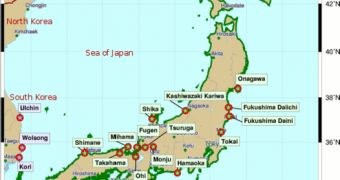Officials from Fukushima nuclear power plant declared that the facility started to release into the atmosphere only half of the amount of radiations it was generating a month ago.This is a sign that plant's representatives have joined efforts in managing this issue, and that improvements are now noticeable.
The Fukushima Daiichi plant, located 240 kilometers (150 miles) from Tokyo, was damaged in March by a devastating earthquake and tsunami.
It will most likely remain in the history as one of the most devastating nuclear events that took place in the 21st century, after Chernobyl chaos, that took place 25 years ago.
"Our latest measurements show that radiation from the damaged reactors is 100 million becquerels per hour, which is one eight-millionth of the amount measured soon after the accident," Tokyo Electric Power's (Tepco) vice president Zengo Aizawa told reporters during a monthly review.
After the disaster, officials stated that reactors suffered nuclear fuel meltdown and they established the achievement of a "cold shutdown" state as a top priority.
The first deadline was set for January, but later on they have expanded the time frame, allowing the project to continue throughout the entire year.
Tepco has worked hard to improve the situation by developing new cooling systems, which would allow the plant to reach the expected condition.
This is a very important issue, on which depends the relocation of thousands of people. The plant was severely affected by the 9.0 earthquake and tsunami that hit Japan on March.
As a direct consequence of this phenomenon, the factory's cooling suffered significant damages. Therefore, Tepco had to manage the issue regarding nuclear radiation leaks.
Also, the Japanese government took a measure of precaution by establishing a 30 km evacuation zone surrounding the plant.
The Japanese government made it clear to the power plant's officials that it would allow the return of 80,000 residents who were evacuated from their homes right after the disaster, only after this target would be completed. The cold shutdown process is considered to be a minimal guarantee for the safety of these inhabitants.
The people who are eager to come back to their homes should be aware of the fact that a lot of new tasks await them. The Japanese environmental ministry declared that 2,400 square km (930 square miles) located in Daiichi might need special attention.
The government suggested that this area should be the target of a decontamination process.
Even once the cold shutdown is established, the people who work at Tepco will still have plenty of work ahead of them. In order to clean all the mess that has been created during the earthquake, it will most likely take a few decades.
Managing the quantity of fuel from reactors and the presence of polluted water, as a result of the early attempts of cooling down the reactors, should represent next two top priorities.
All in all, there is still enough work to do to fix the situation, and officials seem aware of this fact and prepared to face the consequences of the tremendous earthquake.
"We still need to proceed with care. We need to continue monitoring whether the temperatures of the reactors and radiation levels being emitted remain stable going forward,” declared Yoshinori Moriyama, from Nuclear Industrial and Safety Agency.

 14 DAY TRIAL //
14 DAY TRIAL //